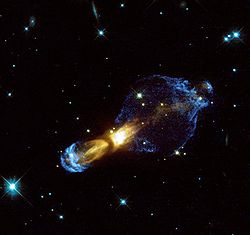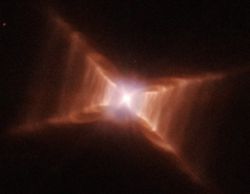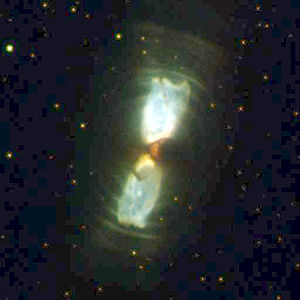
List of protoplanetary nebulae
Encyclopedia
This is a list of protoplanetary nebula
e.
Protoplanetary nebula
A protoplanetary nebula or preplanetary nebula is an astronomical object which is at the short-lived episode during a star's rapid stellar evolution between the late asymptotic giant branch phase and the subsequent planetary nebula phase. A PPN emits strongly in infrared radiation, and is a...
e.
List
| Image | Name | Messier Catalogue | NGC New General Catalogue The New General Catalogue of Nebulae and Clusters of Stars is a well-known catalogue of deep sky objects in astronomy. It contains 7,840 objects, known as the NGC objects... |
Other designation | Date discovered | Distance (ly Light Years Light Years is the seventh studio album by Australian recording artist Kylie Minogue. It was released on 25 September 2000 by Parlophone and Mushroom Records. The album's style was indicative of her return to "mainstream pop dance tunes".... ) |
|---|---|---|---|---|---|---|
 |
Boomerang Nebula Boomerang Nebula The Boomerang Nebula is a protoplanetary nebula located 5,000 light-years away from Earth in the constellation Centaurus. The nebula is measured at , the naturally coldest place currently known in the Universe. The Boomerang Nebula was formed from the outflow of gas from a star at its core... |
Centaurus Bipolar Nebula | About 5,000 | |||
 |
Calabash Nebula Calabash Nebula The Calabash Nebula, also known as the Rotten Egg Nebula or by its technical name OH 231.84 +4.22, is a protoplanetary nebula 1.4 light years long and located some 5,000 light years from Earth in the constellation Puppis.... |
OH231.8+4.2 | About 4,200 | |||
 |
Egg Nebula Egg Nebula The Egg Nebula is a bipolar protoplanetary nebula approximately 3,000 light-years away from Earth. It was discovered by Raghvendra Sahai and John Trauger of NASA's Jet Propulsion Laboratory in Pasadena, California... |
CRL 2688 | 1996 | About 3,000 | ||
 |
Frosty Leo Nebula Frosty Leo Nebula The Frosty Leo Nebula is a protoplanetary nebula located roughly at 3,000 light-years away from Earth in the direction of the constellation Leo. It is a spectral bipolar nebula. Its central star is of optical spectral type K7II, by itself called Frosty Leo... |
IRAS 09371+1212 | About 3,000 | |||
 |
Red Rectangle Nebula Red Rectangle nebula The Red Rectangle Nebula, so called because of its red color and unique rectangular shape, is a protoplanetary nebula in the Monoceros constellation. Also known as HD 44179, the nebula was discovered in 1973 during a rocket flight associated with the AFCRL Infrared Sky Survey called Hi Star... |
HD 44179 | 1973 | 2,300 ± 300 | ||
 |
Gomez's Hamburger Gomez's Hamburger Gomez's Hamburger is believed to be a young star surrounded by a protoplanetary disk. It was initially identified as a protoplanetary nebula , and its distance therefore wrongly estimated to be approximately 6500 light-years away from planet Earth... |
IRAS 18059-3211 | 1985 | 6500 | ||
 |
Cotton Candy Nebula Cotton Candy Nebula The Cotton Candy Nebula is a protoplanetary nebula that was originally discovered by the IRAS satellite. It is also known as IRAS 17150-3224. It is a good example of a DUPLEX-type PPN .R.A. 17h18'20"Decl. -32 27'22"Constellation: Ara... |
IRAS 17150-3224 | ||||
| Water lily nebula Water Lily Nebula The Water Lily Nebula, in the southern constellation of Ara, is a pre-planetary nebula also known as IRAS 16594-4656, in the process of developing to a planetary nebula. It is one of the pre-planetary nebulae containing polycyclic aromatic hydrocarbons, organic hydrocarbons otherwise constituting... |
IRAS 16594-4656 | |||||
| IRAS 22036+5306 | About 6,500 | |||||
| Westbrook Nebula Westbrook Nebula Westbrook Nebula is an asphericalprotoplanetary nebula. It is being formed by a star that has passed through the red giant phase and has ceased nuclear fusion at its core. This star is concealed at the center of the nebula, and is ejecting gas and dust at velocities of up to 200 km/s. The... |
IRAS 04395+3601 | |||||
| IRAS 13208-6020 | ||||||
| IRAS 20068+4051 | ||||||
| IRAS 23166+1655 IRAS 23166+1655 IRAS 23166+1655 is thought to be a preplanetary nebula surrounding LL Pegasi , a binary system that includes an extreme carbon star. The pair is hidden by the dust cloud ejected from the carbon star and is only visible in infrared light.... |
||||||
| M1-92 M1-92 M1-92 is a planetary nebula. It was imaged by the Hubble Space Telescope in the 1990s. The bipolar planetary nebula has a particular form of twin lobes of material that emanates from a central star. Astronomers have dubbed this object as the Footprint Nebula.-External links:*... |
IRAS 19343+2926 | About 8000 | ||||
| IRAS 19024+0044 | 11 000 | |||||
| IRAS 17163-3907 IRAS 17163-3907 IRAS 17163-3907 is a yellow hypergiant star located 13,000 light years from Earth in the constellation of Scorpius, making it the closest-known yellow hypergiant to Earth. The star is embedded in thick shells of expelled gases and dust, and owing to its appearance has been nicknamed by astronomers... |
13 000 |

